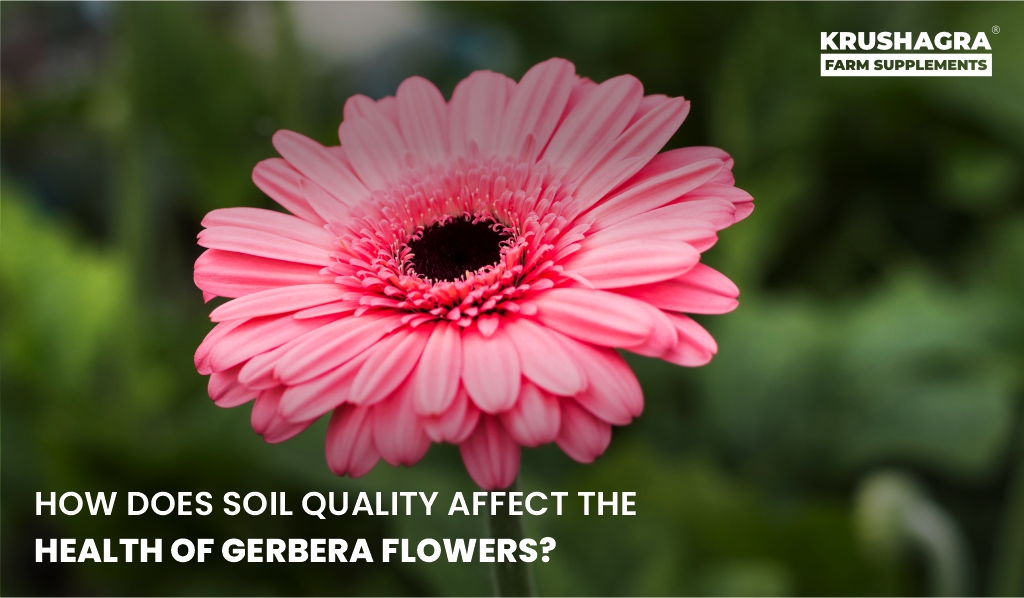Gerbera daisies, with their vibrant colors and striking appearance, are a favorite among gardeners and florists alike.
These flowers are not only aesthetically pleasing but also relatively easy to grow, provided their basic needs are met. One of the most critical factors influencing the health and vitality of gerbera flowers is soil quality.
In this comprehensive guide, we’ll explore how soil quality affects gerbera flowers, what type of soil they thrive in, and how you can optimize soil conditions to ensure your gerberas flourish.
Understanding Gerbera Flowers: A Brief Overview
Before diving into the specifics of soil quality, it’s essential to understand the basic requirements of gerbera flowers.
Native to South Africa, gerberas (Gerbera jamesonii) are perennial plants that belong to the Asteraceae family. They are known for their large, daisy-like flowers that come in a variety of colors, including red, yellow, orange, pink, and white.
Gerberas prefer warm climates and thrive in well-draining soil with plenty of organic matter. They require ample sunlight, consistent moisture, and proper nutrition to produce healthy blooms.
However, the foundation of all these requirements lies in the quality of the soil in which they are planted.
The Role of Soil in Plant Health
Soil is more than just a medium for anchoring plants; it is a complex ecosystem that provides essential nutrients, water, and oxygen to plant roots.
The quality of soil directly impacts a plant’s ability to absorb these vital resources, which in turn affects its overall health, growth, and flowering potential.
For gerbera flowers, soil quality plays a pivotal role in determining:
- Nutrient Availability: Soil acts as a reservoir for essential nutrients like nitrogen, phosphorus, potassium, and micronutrients. Poor soil quality can lead to nutrient deficiencies, stunted growth, and reduced flowering.
- Water Retention and Drainage: Gerberas require consistent moisture but are susceptible to root rot if the soil retains too much water. Well-draining soil ensures that excess water is removed, preventing waterlogged conditions.
- Root Health: Healthy roots are the foundation of a healthy plant. Soil that is too compacted or lacks aeration can restrict root growth, leading to poor nutrient uptake and weakened plants.
- pH Balance: Soil pH affects the availability of nutrients. Gerberas prefer slightly acidic to neutral soil (pH 5.5 to 6.5). Soil that is too acidic or alkaline can hinder nutrient absorption.
Key Soil Characteristics for Gerbera Flowers
To ensure your gerbera flowers thrive, it’s crucial to understand the specific soil characteristics that contribute to their health. Here are the key factors to consider:
1. Soil Texture and Structure
Gerberas prefer loamy soil, which is a balanced mixture of sand, silt, and clay. Loamy soil offers the ideal combination of drainage and water retention, ensuring that the roots receive adequate moisture without becoming waterlogged.
- Sandy Soil: While sandy soil drains well, it often lacks the necessary nutrients and organic matter. Amending sandy soil with compost or well-rotted manure can improve its fertility and water-holding capacity.
- Clay Soil: Clay soil retains water but can become compacted, restricting root growth and reducing aeration. Adding organic matter or sand can improve drainage and structure.
- Silt Soil: Silt soil has fine particles that hold moisture well but can become compacted. It benefits from the addition of organic matter to enhance aeration.
2. Soil pH
As mentioned earlier, gerberas prefer slightly acidic to neutral soil with a pH range of 5.5 to 6.5. Soil pH affects the availability of essential nutrients:
- Acidic Soil (pH below 5.5): In acidic soil, nutrients like phosphorus, calcium, and magnesium become less available. Adding lime can help raise the pH to the desired range.
- Alkaline Soil (pH above 6.5): Alkaline soil can limit the availability of iron, manganese, and zinc, leading to nutrient deficiencies. Sulfur or peat moss can be added to lower the pH.
Regularly testing your soil’s pH and making necessary adjustments will ensure that your gerberas have access to the nutrients they need.
3. Organic Matter Content
Organic matter is a critical component of healthy soil. It improves soil structure, enhances water retention, and provides a steady supply of nutrients as it decomposes. Incorporating organic matter such as compost, well-rotted manure, or leaf mold into the soil can significantly benefit gerbera flowers.
Organic matter also encourages the growth of beneficial microorganisms that contribute to soil health. These microorganisms break down organic material, releasing nutrients in a form that plants can easily absorb.
4. Drainage and Aeration
Proper drainage is essential for gerbera flowers, as they are prone to root rot in waterlogged conditions. Well-draining soil ensures that excess water is removed, preventing the roots from sitting in stagnant water.
Aeration is equally important, as it allows oxygen to reach the roots. Compacted soil can restrict root growth and reduce the plant’s ability to absorb nutrients.
Regularly loosening the soil and adding organic matter can improve aeration.
5. Nutrient Levels
Gerberas require a balanced supply of essential nutrients to thrive. The primary macronutrients—nitrogen (N), phosphorus (P), and potassium (K)—play crucial roles in plant health:
- Nitrogen: Promotes leafy growth and vibrant green foliage. However, excessive nitrogen can lead to lush foliage at the expense of flowers.
- Phosphorus: Supports root development and flower production. A deficiency in phosphorus can result in poor blooming.
- Potassium: Enhances overall plant health, improves disease resistance, and strengthens stems.
In addition to macronutrients, gerberas require micronutrients like iron, magnesium, and calcium. A soil test can help determine nutrient levels and guide fertilization practices.
How to Improve Soil Quality for Gerbera Flowers
If your soil doesn’t meet the ideal conditions for gerbera flowers, don’t worry! There are several steps you can take to improve soil quality and create a thriving environment for your plants.
1. Conduct a Soil Test
Before making any amendments, it’s essential to understand your soil’s current condition. A soil test will provide valuable information about pH, nutrient levels, and organic matter content.
2. Amend the Soil
Based on the results of your soil test, you can make targeted amendments to improve soil quality:
- Adjust pH: If your soil is too acidic, add lime to raise the pH. If it’s too alkaline, incorporate sulfur or peat moss to lower the pH.
- Add Organic Matter: Incorporate compost, well-rotted manure, or leaf mold to improve soil structure, fertility, and water retention.
- Improve Drainage: If your soil is heavy clay, add sand or perlite to enhance drainage. For sandy soil, add organic matter to improve water retention.
3. Mulch the Soil
Applying a layer of organic mulch, such as straw, wood chips, or shredded leaves, around your gerbera plants can help conserve moisture, regulate soil temperature, and suppress weeds. As the mulch decomposes, it will also contribute to soil fertility.
4. Fertilize Regularly
Gerberas benefit from regular fertilization to maintain optimal nutrient levels. Use a balanced, water-soluble biofertilizer, and/ or those with equal parts nitrogen, phosphorus, and potassium (e.g., 10-10-10) during the growing season. Be cautious not to over-fertilize, as this can lead to excessive foliage growth at the expense of flowers.
5. Practice Crop Rotation
If you’re growing gerberas in the same location year after year, the soil can become depleted of nutrients and more susceptible to pests and diseases. Practicing crop rotation by planting different types of plants in the area can help maintain soil health.
Common Soil-Related Problems and Solutions
Even with the best care, gerbera flowers can encounter soil-related issues. Here are some common problems and how to address them:
1. Root Rot
Root rot is a fungal disease that occurs when the soil is too wet and poorly drained. To prevent root rot, ensure that your soil has excellent drainage and avoid overwatering. If root rot is already present, remove affected plants and improve soil drainage before replanting.
2. Nutrient Deficiencies
Yellowing leaves, stunted growth, and poor flowering can indicate nutrient deficiencies. Conduct a soil test to identify the missing nutrients and amend the soil accordingly. Regular fertilization can also help prevent deficiencies.
3. Soil Compaction
Compacted soil restricts root growth and reduces aeration. Loosen the soil by gently tilling or aerating it, and incorporate organic matter to improve structure.
4. Pest Infestations
Poor soil quality can weaken plants, making them more susceptible to pests. Maintaining healthy soil through proper amendments and fertilization can help strengthen your gerberas and reduce the risk of pest infestations.
Let’s Sum It Up
Soil quality is a fundamental factor in the health and vitality of gerbera flowers. By understanding the specific soil requirements of gerberas and taking steps to optimize soil conditions, you can create an environment where these beautiful flowers thrive.
Regular soil testing, proper amendments, and consistent care will ensure that your gerberas receive the nutrients, moisture, and aeration they need to produce stunning blooms season after season.
Whether you’re a seasoned gardener or a beginner, paying attention to soil quality is one of the most effective ways to enhance the health and beauty of your gerbera flowers.
So, roll up your sleeves, get your hands dirty, and watch your gerberas flourish in the perfect soil!
FAQ’s
1. What type of soil is best for gerbera flowers?
Gerbera flowers thrive in well-draining, loamy soil that is rich in organic matter. The ideal soil should have a slightly acidic to neutral pH (5.5 to 6.5) to ensure optimal nutrient availability.
2. How often should I fertilize gerbera flowers?
Gerberas benefit from regular fertilization during the growing season. Use a balanced, water-soluble fertilizer (e.g., 10-10-10) every 4-6 weeks. Avoid over-fertilizing, as this can lead to excessive foliage growth and fewer blooms.
3. How can I improve drainage in heavy clay soil?
To improve drainage in heavy clay soil, incorporate organic matter such as compost or well-rotted manure. You can also add sand or perlite to enhance drainage and prevent waterlogging.
4. What should I do if my gerbera flowers show signs of nutrient deficiencies?
If your gerbera flowers show signs of nutrient deficiencies, such as yellowing leaves or stunted growth, conduct a soil test to identify the missing nutrients. Amend the soil with the appropriate fertilizers or organic matter to address the deficiencies.
5. Can I grow gerbera flowers in pots?
Yes, gerbera flowers can be grown in pots as long as the soil is well-draining and rich in organic matter. Ensure the pot has drainage holes to prevent waterlogging, and use a high-quality potting mix designed for flowering plants. Regular fertilization and proper watering are essential for potted gerberas.





